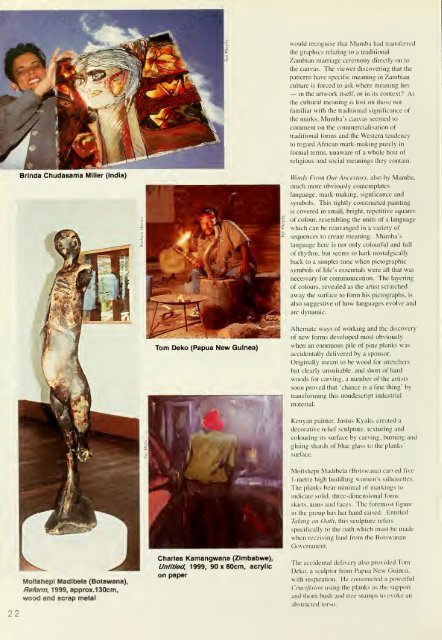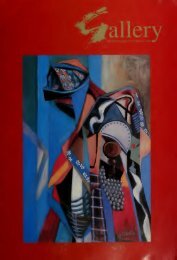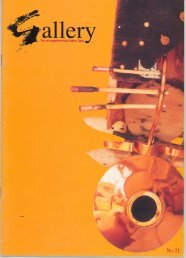Gallery : the art magazine from Gallery Delta
Gallery : the art magazine from Gallery Delta
Gallery : the art magazine from Gallery Delta
Create successful ePaper yourself
Turn your PDF publications into a flip-book with our unique Google optimized e-Paper software.
22<br />
Brinda Chudasama Miller (India)<br />
MoltshepI Madlbela (Botswana),<br />
Reform, 1999, approx.130cm,<br />
wood and scrap metal<br />
Tom Deko (Papua New Guinea)<br />
Charles Kamangwana (Zimbabwe),<br />
Untitled, 1999, 90 x 80cm, acrylic<br />
on paper<br />
would recognise that Muniba had transferred<br />
<strong>the</strong> graphics relating to a traditional<br />
Zambian marriage ceremony directly on to<br />
<strong>the</strong> canvas. The viewer discovering that <strong>the</strong><br />
patterns have specific meaning in Zambian<br />
culture is forced to ask where meaning lies<br />
— in <strong>the</strong> <strong>art</strong>work itself, or in its context? As<br />
<strong>the</strong> cultural meaning is lost on those not<br />
familiar with <strong>the</strong> traditional significance of<br />
<strong>the</strong> marks. Mumba's canvas seemed to<br />
comment on <strong>the</strong> commercialisation of<br />
traditional forms and <strong>the</strong> Western tendency<br />
to regard African mark-making purely in<br />
formal terms, unaware of a whole host of<br />
religious and social meanings <strong>the</strong>y contain.<br />
V/ords From Our Ancestors, also by Mumba,<br />
much more obviously contemplates<br />
language, mark-making, signficance and<br />
symbols. This tightly constructed painting<br />
is covered in small, bright, repetitive squares<br />
of colour, resembling <strong>the</strong> units of a language<br />
which can be rearranged in a variety of<br />
sequences to create meaning. Mumba's<br />
language here is not only colourful and full<br />
of rhythm, but seems to hark nostalgically<br />
back to a simpler time when pictographic<br />
symbols of life's essentials were all that was<br />
necessary for communication. The layering<br />
of colours, revealed as <strong>the</strong> <strong>art</strong>ist scratched<br />
away <strong>the</strong> surface to form his pictographs, is<br />
also suggestive of how languages evolve and<br />
are dynamic.<br />
Alternate ways of working and <strong>the</strong> discovery<br />
of new forms developed most obviously<br />
when an enormous pile of pine planks was<br />
accidentally delivered by a spon.sor<br />
Originally meant to be wood for stretchers<br />
but clearly unsuitable, and short of hard<br />
woods for carving, a number of <strong>the</strong> <strong>art</strong>ists<br />
soon proved that chance is a fine thing" by<br />
transforming this nondescript industrial<br />
material.<br />
Kenyan painter, Justus Kyalo. created a<br />
decorative relief sculpture, texturing and<br />
colouring its surface by carving, burning and<br />
gluing shards of blue glass to <strong>the</strong> planks"<br />
surface.<br />
Moitshepi Madibela (Botswana) car\ed five<br />
I -metre high huddling uomen's silhouettes.<br />
The planks bear minimal of markings to<br />
indicate .solid, three-dimensional form:<br />
skirts, arms and faces. The foremost figure<br />
in <strong>the</strong> group has her hand raised. I-'iUitled<br />
Tiikiiii; nil (huh. this sculpture refers<br />
specifically to <strong>the</strong> oath which must be made<br />
when receiving land <strong>from</strong> <strong>the</strong> Botswanan<br />
Ciovernmenl.<br />
Ihc accidental delivery also provided Tom<br />
Deko, a sculptor trom Papua New Guinea,<br />
with inspiration. He constructed a powerful<br />
CriHifi^ioii using <strong>the</strong> planks as <strong>the</strong> support<br />
and thorn bush and tree stumps lo evoke an<br />
abstracted torso.







